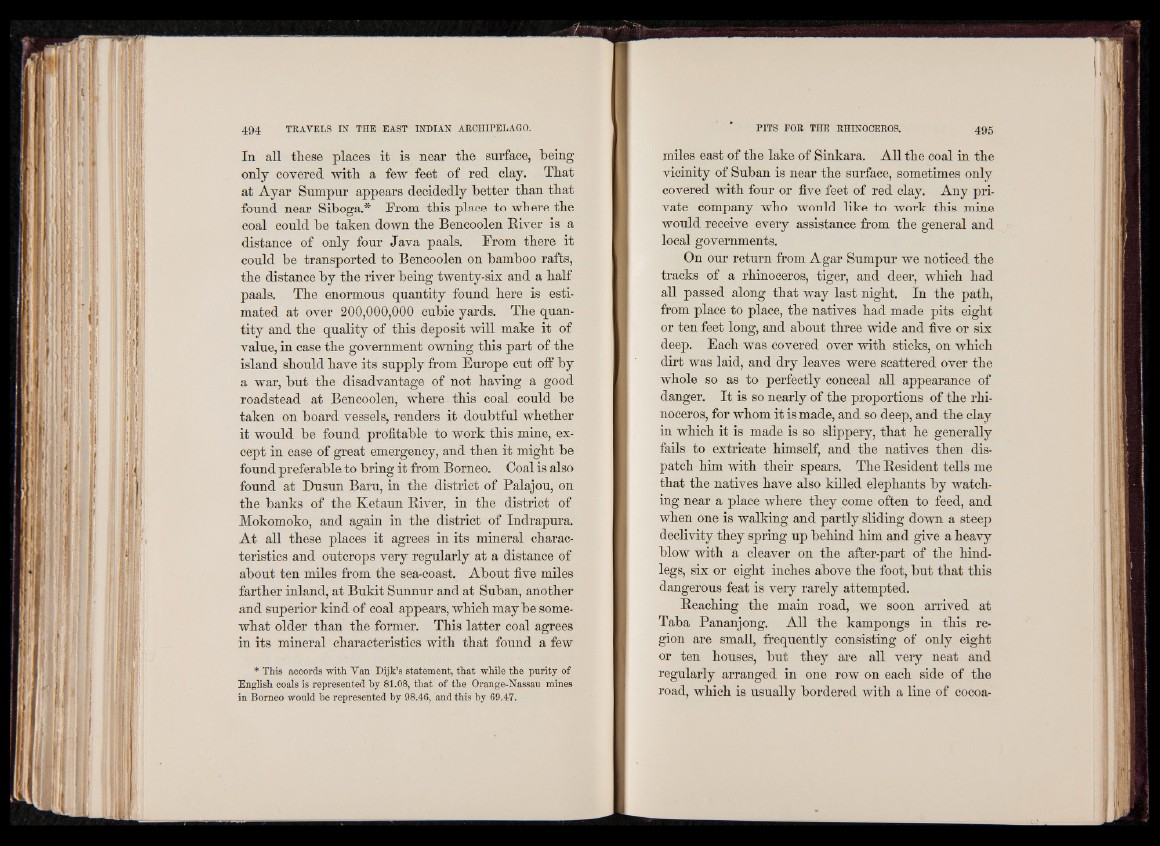
In all tliese places it is near tlie surface, being
only covered with a few feet of red clay. That
at Ayar Sumpur appears decidedly better than that
found near Siboga.* From this place to where the
coal could be taken down the Bencoolen River is a
distance of only four Java paals. From there it
could be transported to Bencoolen on bamboo rafts,
the distance by the river being twenty-six and a half
paals. The enormous quantity found here is estimated
at over 200,000,000 cubic yards. The quantity
and the quality of this deposit will make it of
value, in case the government owning this part of the
island should have its supply from Europe cut off by
a war, but the disadvantage of not having a good
roadstead at Bencoolen, where this coal could be
taken on board vessels, renders it doubtful whether
it would be found profitable to work this mine, except
in case of great emergency, and then it might be
found preferable to bring it from Borneo. Coal is also
found at Dusun Baru, in the district of Palajou, on
the banks of the Ketaun River, in the district of
Mokomoko, and again in the district of Indrapura.
At all these places it agrees in its mineral characteristics
and outcrops very regularly at a distance of
about ten miles from the sea-coast. About five miles
farther inland, at Bukit Sunnur and at Suban, another
and superior kind of coal appears, which maybe somewhat
older than the former. This latter coal agrees
in its mineral characteristics with that found a few
* This accords with Van Dijk’s statement, that while the purity of
English coals is represented by 81.08, that of the Orange-Nassau mines
in Borneo would be represented by 98.46, and this by 69.47.
miles east of the lake of Sinkara. All the coal in the
vicinity of Suban is near the surface, sometimes only
covered with four or five feet of red clay. Any private
company who would like to work this mine
would receive every assistance from the general and
local governments.
On our return from Agar Sumpur we noticed the
tracks of a rhinoceros, tiger, and deer, which had
all passed along that way last night. In the path,
from place to place, the natives had made pits eight
or ten feet long, and about three wide and five or six
deep. Each was covered over with sticks, on which
dirt was laid, and dry leaves were scattered over the
whole so as to perfectly conceal all appearance of
danger. It is so nearly of the proportions of the rhinoceros,
for whom it is made, and so deep, and the clay
in which it is made is so slippery, that he generally
fails to extricate himself, and the natives then dispatch
him with their spears. The Resident tells me
that the natives have also killed elephants by watching
near a place where they come often to feed, and
when one is walking and partly sliding down a steep
declivity they spring up behind him and give a heavy
blow with a cleaver on the after-part of the hindlegs,
six or eight inches above the foot, but that this
dangerous feat is very rarely attempted.
Reaching the main road, we soon arrived at
Taba Pananjong. All the kampongs in this region
are small, frequently consisting of only eight
or ten houses, but they are all very neat and
regularly arranged in one row on each side of the
road, which is usually bordered with a line of cocoa